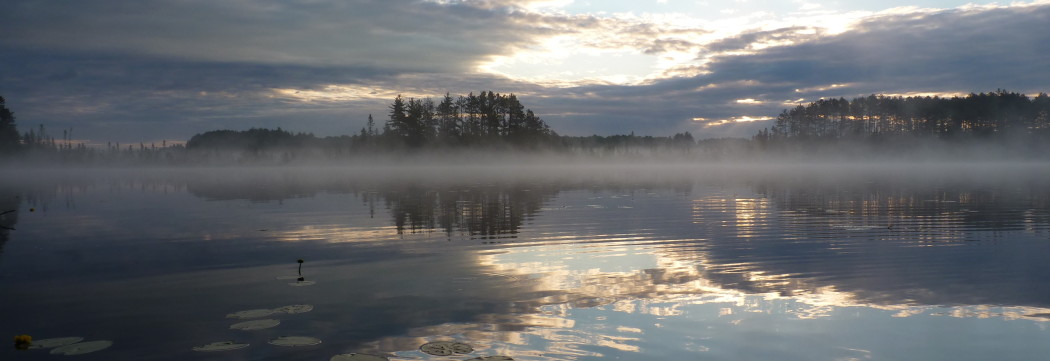 To get to the seekers’ camp in Nishnajida (Ojibwe for Camp Where the Old Ways Return), the wilderness guides need to hike about a mile into the forest through thick undergrowth, rooted pathways, and then carefully make their way across a bog by crossing a makeshift log bridge. The camp is found in the heart of the Chequamegon-Nicolet National Forest. There are no roads or sign posts to help with navigation; one simply learns to read the landscape to follow the barely noticeable trail among the trees. The only way in or out of camp is by foot or canoe. The guides make the trek out to see the seekers to give guidance on wilderness survival skills, direction for projects, assist with group discussions and dynamics, and to drop off supplies when needed.
To get to the seekers’ camp in Nishnajida (Ojibwe for Camp Where the Old Ways Return), the wilderness guides need to hike about a mile into the forest through thick undergrowth, rooted pathways, and then carefully make their way across a bog by crossing a makeshift log bridge. The camp is found in the heart of the Chequamegon-Nicolet National Forest. There are no roads or sign posts to help with navigation; one simply learns to read the landscape to follow the barely noticeable trail among the trees. The only way in or out of camp is by foot or canoe. The guides make the trek out to see the seekers to give guidance on wilderness survival skills, direction for projects, assist with group discussions and dynamics, and to drop off supplies when needed.
 The seekers visit Nadmadiwining (Ojibwe for Support Camp) one sun each new moon to give them opportunity to conduct field guide research at the Teaching Drum library and to check in with friends and family. Having already lived immersed in the wilds for over 4 moons means the seekers’ senses are now heightened and acclimated to natural sounds, making them more vulnerable to becoming overwhelmed by modern day noises that most of us might not notice. When they visit Nadmadiwining, a buffer is maintained between the seekers and the busy projects happening at the School to help them transition between Nadmadiwining and camp more easily.
The seekers visit Nadmadiwining (Ojibwe for Support Camp) one sun each new moon to give them opportunity to conduct field guide research at the Teaching Drum library and to check in with friends and family. Having already lived immersed in the wilds for over 4 moons means the seekers’ senses are now heightened and acclimated to natural sounds, making them more vulnerable to becoming overwhelmed by modern day noises that most of us might not notice. When they visit Nadmadiwining, a buffer is maintained between the seekers and the busy projects happening at the School to help them transition between Nadmadiwining and camp more easily.
At camp, a typical sun for the seekers begins at sunrise with the first one up giving a Wolf howl, letting the others know it’s time to greet the morning. After about a quarter meal time, they gather together to divide up the morning tasks. On most suns, they fish, gather greens, and collect firewood, all before breakfast. Within the next two moons, their morning routine will change to adapt to the fall season with its cooler temperatures and shorter suns.
Breakfast is leftovers from the night before, supplemented by whatever food they gathered that morning or is left over from the food drop. Food drops occur as needed and contain fat, vegetables, and fruit which have steadily decreased as the seekers have learned to forage for greens and fish. All meals are prepared and eaten together. About two moons ago they turned in their cooking pot in order to learn and practice primitive cooking methods such as rock boiling, roasting, and burying food in the hot ashes. They also gave up their matches over a moon ago, so fire is made at the hearth with a bow drill. Each seeker has crafted a fire kit and continues to hone her/his fire-making skills so that she/he can summon the gift of fire in any type of weather or situation. So far, each sun someone has managed to make fire for cooking.
After breakfast, they work on a specific project or task. Their current project entails dismantling and rebuilding a few of the wigwams at camp, those they will be living in during the fall season. To prepare for this, they are foraging for building materials, such as flexible Saplings and Spruce Root.
The seekers tend to be ambitious when it comes to the number of tasks they want to complete each sun. At the beginning of the Wilderness Guide Program, their to-do lists were optimistically extensive. But after a while, they realized that outside factors such as weather or the guides visiting camp kept interfering with their plans. At first, this frustrated them. But they soon learned that it was better to adapt and go with the flow. If the weather is sunny, they may choose to bathe and wash clothes in the lake. If it’s raining, they stay inside their tents and write letters or sew. If the guides come just before they are planning to forage for Spruce Root or process hides, they practice staying relaxed about the change in plans, telling themselves that they’ll do it the next sun, or the next sun, or the next…
Stay tuned for more adventures from the wild…



